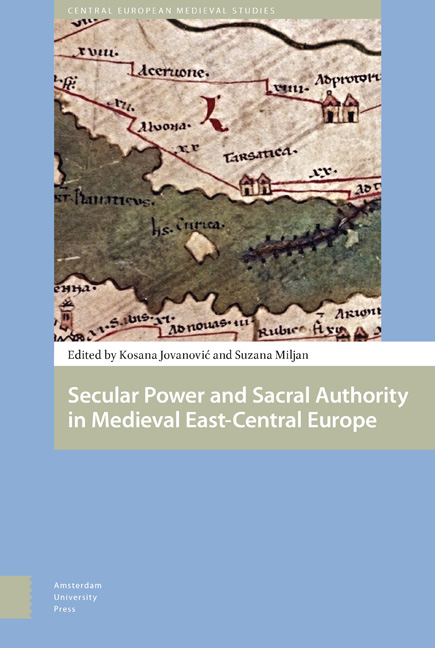Book contents
- Frontmatter
- Contents
- List of Figures and Tables
- Acknowledgements
- Foreword
- Folklore of the Medieval Kings of Hungary: Preliminary Research Report
- Variations on Nobility in Central and South-Eastern Europe: An Introduction
- The Changes of Office of Ban of Slavonia after the Mongol Invasion in Hungary (1242-1267)
- The Reconstruction and Role of Roads in the Formation of a Medieval Cultural Landscape: The Example of Episcopal Estates of Dubrava, Ivanić and Čazma
- From Castle-Warrior to Nobleman: Case Study of a Family of Slavonian Lesser Nobility
- Late Medieval Village in Turopolje (Slavonia): The Example of Donja Lomnica
- Economic Development and Transformation of the Pauline Monasteries near Senj under the Frankapan Patronage
- The Society of the Noble Judges in Northeastern Hungary during the Reign of King Sigismund (1387-1437)
- Development of Ragusan Diplomatic Service in the First Half of the Fifteenth Century: Father and Son at the Court of Duke Sandalj Hranić
- Croatian Students at the University of Prague in the Fifteenth Century
- A Contribution to Medieval Croatian Diplomatics: Cyrillic Charters of Croatian Nobility from the Franciscan Monastery on Trsat in Rijeka
- Peter of Crkvica, a Man Who Could Be Trusted: The Career of a Middle-Ranking Cleric and Diplomat in the Kingdom of Hungary in Mid-Fifteenth Century
- The Nobility of the Despotate of Serbia between Ottoman Empire and Hungary (1457-1459)
- List of Contributors
- Index
From Castle-Warrior to Nobleman: Case Study of a Family of Slavonian Lesser Nobility
Published online by Cambridge University Press: 12 December 2020
- Frontmatter
- Contents
- List of Figures and Tables
- Acknowledgements
- Foreword
- Folklore of the Medieval Kings of Hungary: Preliminary Research Report
- Variations on Nobility in Central and South-Eastern Europe: An Introduction
- The Changes of Office of Ban of Slavonia after the Mongol Invasion in Hungary (1242-1267)
- The Reconstruction and Role of Roads in the Formation of a Medieval Cultural Landscape: The Example of Episcopal Estates of Dubrava, Ivanić and Čazma
- From Castle-Warrior to Nobleman: Case Study of a Family of Slavonian Lesser Nobility
- Late Medieval Village in Turopolje (Slavonia): The Example of Donja Lomnica
- Economic Development and Transformation of the Pauline Monasteries near Senj under the Frankapan Patronage
- The Society of the Noble Judges in Northeastern Hungary during the Reign of King Sigismund (1387-1437)
- Development of Ragusan Diplomatic Service in the First Half of the Fifteenth Century: Father and Son at the Court of Duke Sandalj Hranić
- Croatian Students at the University of Prague in the Fifteenth Century
- A Contribution to Medieval Croatian Diplomatics: Cyrillic Charters of Croatian Nobility from the Franciscan Monastery on Trsat in Rijeka
- Peter of Crkvica, a Man Who Could Be Trusted: The Career of a Middle-Ranking Cleric and Diplomat in the Kingdom of Hungary in Mid-Fifteenth Century
- The Nobility of the Despotate of Serbia between Ottoman Empire and Hungary (1457-1459)
- List of Contributors
- Index
Summary
In the Árpadian period the society of the Kingdom of Hungary was divided into several groups. Each group had its own particular status, including complex systems of services and rights, which were characteristic exclusively to a particular group. At the edges of this spectrum one can find both nobles and tenant-peasants or serfs. The system functioned in such a manner that nobles had most of the rights and offered few of the services, while serfs had no rights at all. However, between these two extreme points there were several other individuals, who bore various statuses; some types of liberties were connected to certain duties. Until the fourteenth century this diversity of social statuses disappeared, and society was divided into two big groups: nobles and tenant peasants (Lat. iobagio). However, in Slavonia, though it was a part of medieval Hungary south of the River Drava, this social process was a bit different: members belonged to one among the types of these special liberties, the strata of the so-called castle-warriors (Lat. iobagiones castri, Hung. várjobbágyok), successfully ‘survived’ these changes, and during the fifteenth century they were mentioned in the charters as nobles belonging to a castle (Lat. nobiles castri, Hung. várnemesek). The castle-warriors and castle nobles were closely connected to their own comitatus.
The word comitatus meant two different things in the Latin sources of the medieval Kingdom of Hungary. On the one hand, it was the name of each unit of the castle-system (Hung. várispánság). In the centre of this unit stood a castle, and the person who was its head was called comes, and was in charge of the appertaining estates. On the other hand, comitatus was also the term for larger territorial unit which formed the administrative system of the Kingdom (Hung. megye); it contained all the lands and possessions regardless whether they belonged to ecclesiastical or secular lords or even royalty. The head of the royal county was called comes as well, and in the early period he was actually the same person who was the head of the respective castle district. However, in many cases royal counties contained more than one castle district. Until the fourteenth century some castle districts merged into another comitatus, and vanished completely (for example, the castle district called Karakó became the part of the royal county named Vas at the western borders of the Kingdom).
- Type
- Chapter
- Information
- Publisher: Amsterdam University PressPrint publication year: 2018



